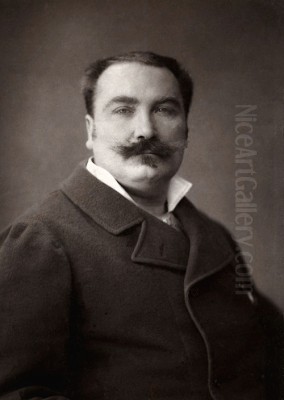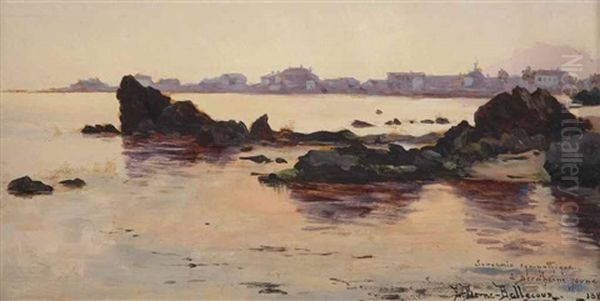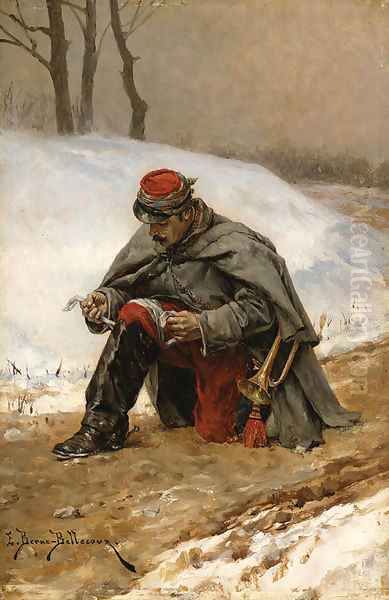Introduction: An Artist Forged in Tradition and Conflict

Etienne Prosper Berne-Bellecour stands as a significant figure in late 19th and early 20th-century French art. Born on July 29, 1838, in Boulogne-sur-Mer, and passing away on November 26, 1910, his life spanned a period of dramatic change in France, both politically and artistically. While proficient as an engraver, illustrator, and etcher, Berne-Bellecour is primarily celebrated for his paintings, particularly those depicting military life and scenes from the Franco-Prussian War. His work provides a detailed, realistic, and often poignant glimpse into the world of the French soldier, rendered with the technical skill characteristic of the academic tradition in which he was trained. His direct participation in conflict lent an undeniable authenticity to his canvases, setting him apart from artists who depicted war purely from imagination.
Berne-Bellecour was not merely a painter of battles; his oeuvre also encompassed landscapes, portraits, and genre scenes, showcasing a versatility often overlooked due to the prominence of his military subjects. He navigated the complex art world of Paris, exhibiting regularly and achieving recognition, yet remained somewhat distinct from the avant-garde movements like Impressionism that were concurrently challenging artistic conventions. His legacy is that of a dedicated craftsman, a keen observer of his times, and a visual historian whose works continue to offer valuable insights into the military culture and social fabric of the French Third Republic.
Early Life and Artistic Formation in Paris
Born into a family with connections to the arts – his father was reportedly a playwright and his mother an actress – Etienne Prosper Berne-Bellecour seemed destined for a creative path. His formative years were spent absorbing the cultural atmosphere of his time. Seeking formal training, he moved to Paris, the undisputed center of the European art world. In 1856, he gained admission to the prestigious École des Beaux-Arts, the bastion of academic art education in France. This institution emphasized rigorous training in drawing, composition, and the study of classical and Renaissance masters.

At the École, Berne-Bellecour studied under several respected masters of the academic style. His teachers included Émile Signol, known for his historical and religious paintings, François-Joseph Picard, and Félix-Joseph Barrias, another prominent historical painter. Under their tutelage, Berne-Bellecour honed the technical skills essential for success within the established art system: precise draughtsmanship, balanced composition, and a polished finish. This solid grounding in academic principles would underpin his entire artistic career, regardless of the subject matter he chose.
Like many aspiring artists of his generation, Berne-Bellecour aimed for the ultimate academic accolade: the Prix de Rome. This prestigious scholarship offered winners the chance to study for several years at the French Academy in Rome, immersing themselves in classical antiquity and Renaissance art. Berne-Bellecour competed for the prize, likely around 1859, but was unsuccessful. This setback, while disappointing, did not derail his artistic ambitions. Instead, he began to carve out a career through other avenues available to young artists in Paris.
Initially, Berne-Bellecour found work as an illustrator, contributing drawings to newspapers and periodicals. This field provided not only income but also valuable experience in narrative composition and meeting deadlines. It required an ability to quickly capture scenes and figures, a skill that would serve him well later in his career. Alongside illustration, he began developing his skills as a painter, initially exploring landscapes and portraiture before finding the niche that would define his reputation.
The Crucible of War: Service and Subject Matter
The Franco-Prussian War of 1870-1871 proved to be a pivotal experience in Berne-Bellecour's life and art. Unlike artists who observed the conflict from afar, Berne-Bellecour actively participated. He served in the francs-tireurs, irregular military forces, specifically with the unit known as the "Tirailleurs de la Seine" (Snipers, or Skirmishers, of the Seine). This direct involvement in the defense of Paris and the subsequent fighting provided him with firsthand knowledge of military life, the realities of combat, and the appearance of soldiers and their equipment under field conditions.
His bravery and service did not go unnoticed; he was awarded a military medal for his actions during the war. This experience profoundly shaped his artistic direction. The intensity, camaraderie, hardship, and patriotism he witnessed became central themes in his work. He emerged from the conflict not just as a painter interested in military subjects, but as a veteran who could imbue his canvases with a sense of lived reality. This authenticity resonated with a public eager for images that reflected the nation's recent trials and the perceived heroism of its soldiers.

Following the war, Berne-Bellecour dedicated much of his artistic energy to military painting. His works from this period often depict French soldiers in various situations: on patrol, in camp, during maneuvers, or in the heat of battle. He paid meticulous attention to the details of uniforms, weaponry, and accoutrements, reflecting his academic training and his desire for accuracy. His paintings were not typically grand, allegorical depictions of war, but rather focused, often intimate portrayals of the soldier's experience.
Key works stemming from this period showcase his approach. Le Coup de Canon (The Cannon Shot), painted shortly after the war in 1872, captures the intense moment of artillery fire with dramatic realism. Les Prisonniers (The Prisoners) likely reflects scenes he witnessed, depicting captured soldiers with a somber dignity. Paintings documenting specific engagements, such as the Défense du château de Montretout (sometimes referred to as the Defense of Malmaison) or scenes from the Battle of Buzenval (like Combat à la porte de Longboyau du château de Buzenval, 1871), provided visual records of the conflict, combining topographical accuracy with human drama.
Expanding Horizons: Landscapes, Portraits, and Graphic Arts
While Berne-Bellecour gained renown for his military scenes, his artistic output was more diverse than this focus might suggest. He continued to paint landscapes throughout his career, often capturing the serene beauty of the French countryside or coastal areas. These works demonstrate his sensitivity to light and atmosphere, providing a contrast to the tension and detail of his military subjects. A notable example is A seaside village at dusk (1884), which showcases his ability to render the subtle effects of light on architecture and water, creating a tranquil mood far removed from the battlefield.
Portraiture also formed part of his practice. Although perhaps less numerous than his military or landscape works, his portraits likely catered to private commissions and allowed him to exercise his skills in capturing likeness and character. These works would have adhered to the polished, realistic standards expected within the academic tradition, emphasizing accurate representation and a certain formal dignity.
Furthermore, Berne-Bellecour remained active in the graphic arts. His early experience as an illustrator likely informed his continued interest in printmaking. He worked as an engraver and etcher, mediums that require precision and control, aligning well with his meticulous artistic temperament. Evidence suggests collaborations, such as his work with Michel Thibaud under the shared pseudonym "Helios" for producing engravings. This aspect of his career highlights his versatility and his engagement with different modes of artistic production and dissemination.
Genre scenes, depicting everyday life or anecdotal moments, also appear in his oeuvre. Works like A Lover's Nest suggest an interest in narrative vignettes beyond the military sphere. Another title sometimes associated with him, La gardienne de cochon (The Pig Keeper), points towards rural themes. These works allowed him to explore different compositional challenges and emotional tones, demonstrating a broader artistic sensibility. His multifaceted career thus encompassed the roles of painter, illustrator, engraver, and etcher, reflecting the diverse opportunities available to artists in the bustling Parisian art scene.
Artistic Style: Realism, Detail, and Academic Roots
Etienne Prosper Berne-Bellecour's artistic style is firmly rooted in the French Academic tradition of the 19th century, characterized by realism, meticulous detail, and a high degree of technical finish. His training at the École des Beaux-Arts instilled in him the importance of accurate drawing, careful modeling of form, and smooth brushwork that minimized the visible trace of the artist's hand. This approach was particularly well-suited to his chosen specialty of military painting, where accuracy in depicting uniforms, equipment, and settings was highly valued by both military personnel and the public.
His realism was informed by direct observation, especially in his military subjects drawn from his Franco-Prussian War experiences. He sought to represent soldiers and their environment authentically, avoiding excessive romanticization or theatricality. His figures are typically well-defined, solid, and anatomically correct. The compositions are carefully constructed, often balancing narrative clarity with a sense of immediacy. He excelled at rendering textures – the rough wool of uniforms, the gleam of metal on rifles and helmets, the dusty ground of a battlefield, or the weathered stone of a building.
Compared to some other prominent military painters of his era, Berne-Bellecour's work often focused on smaller-scale interactions or specific moments rather than vast, panoramic battle scenes. While capable of depicting action, many of his paintings capture soldiers at rest, on reconnaissance, or during drills, emphasizing the routine aspects of military life alongside moments of tension. This focus on the everyday experience of the soldier lends his work a particular kind of intimacy and relatability.
His use of color was generally naturalistic, aiming for accurate representation of light and local color. While his palette could be vibrant when depicting flags or certain uniform elements, it often employed more subdued, earthy tones appropriate for field conditions or landscapes under specific atmospheric effects, as seen in A seaside village at dusk. The overall impression is one of careful observation and skilled execution, prioritizing clarity and verisimilitude over expressive brushwork or bold color experimentation seen in contemporaneous movements like Impressionism.
Influences and the Artistic Milieu
Berne-Bellecour operated within a rich and competitive artistic environment in Paris. His style shows the clear influence of the leading military painters of the time, most notably Jean-Louis-Ernest Meissonier and Édouard Detaille. Meissonier, older and immensely successful, was renowned for his small, highly detailed historical and military scenes, setting a standard for meticulous realism. Detaille, a near-contemporary and friend (and fellow veteran of the Franco-Prussian War), became perhaps the most celebrated French military painter of the late 19th century. Berne-Bellecour shared with Detaille a commitment to accuracy and a focus on the modern French soldier, though Detaille's canvases were often larger and more overtly dramatic.
The broader context of French Academic painting also shaped Berne-Bellecour's work. Artists like Jean-Léon Gérôme, known for his historical and Orientalist scenes executed with photographic precision, exemplified the prevailing standards of technical excellence and polished finish that Berne-Bellecour also adhered to. His own teachers at the École des Beaux-Arts – Émile Signol, François-Joseph Picard, and Félix-Joseph Barrias – represented this academic lineage, emphasizing traditional subjects and techniques.
Beyond these direct influences, Berne-Bellecour interacted with numerous contemporaries. His service in the francs-tireurs alongside other artists like Jules Frédéric Ballavoine and Gustave Jacquet suggests a camaraderie forged in shared experience, which may have extended into their professional lives. The existence of correspondence with figures such as the sculptor Henri Allauard and the writer Marcel Barrière indicates his participation in the wider cultural network of Paris.
While Berne-Bellecour remained largely committed to the academic style, he worked during a period of intense artistic ferment. The Impressionists, including Claude Monet, Edgar Degas, and Camille Pissarro, were challenging the very foundations of academic art, prioritizing capturing fleeting moments, the effects of light, and subjective perception over detailed realism and historical subjects. Although Berne-Bellecour did not adopt their revolutionary techniques or aesthetic goals, the presence of such radical alternatives undoubtedly formed part of the artistic landscape he navigated. His adherence to realism can be seen, in part, as a conscious choice within this diverse environment, catering to a clientele and a public that still valued traditional craftsmanship and recognizable subject matter, particularly in the realm of military and historical art. Another important contemporary military painter, Alphonse de Neuville, also shared this focus on the Franco-Prussian War, often depicting scenes of heroism and resistance with dramatic flair.
Recognition, Later Life, and Legacy
Etienne Prosper Berne-Bellecour achieved considerable recognition during his lifetime within the established art system. While specific records of major art prizes beyond his military medal might be scarce, his regular participation in the Paris Salon was a significant mark of professional standing. The Salon was the most important venue for artists to display their work and gain patronage, and acceptance into its exhibitions was crucial for building a reputation. His detailed and accessible military scenes found favor with the public and critics who appreciated patriotic themes and technical skill.
A tangible sign of his success and official recognition came with his appointment as a Chevalier (Knight) of the Légion d'honneur (Legion of Honour), one of France's highest civilian decorations. This award acknowledged his contributions to French art and culture, and likely also recognized the patriotic dimension of his work, particularly significant in the decades following the Franco-Prussian War as France sought to rebuild national pride.
In his later years, Berne-Bellecour reportedly acquired and undertook the restoration of the Château de Buzenval, a location historically significant due to the battles fought nearby during the Franco-Prussian War, which he himself had depicted. Spending his later years there suggests a deep connection to the history he had both lived through and painted. This act of preservation further links his personal life with the historical themes present in his art.
Berne-Bellecour's legacy lies primarily in his contribution to military painting. He stands as one of the key figures, alongside Detaille and de Neuville, who documented the French army and the experience of the Franco-Prussian War with accuracy and empathy. His work provides valuable visual documentation of uniforms, equipment, and military life of the period. While perhaps not an innovator in the mold of the Impressionists, he was a master craftsman within the academic tradition, producing works of high quality and lasting historical interest.
His paintings continue to be appreciated for their detail, realism, and the insight they offer into a specific historical moment and the lives of ordinary soldiers. They serve as important historical documents as much as works of art, preserving a visual record of a pivotal era in French history. His versatility, extending to landscape, portraiture, and graphic arts, also merits recognition, painting a picture of a dedicated and multifaceted artist working successfully within the mainstream art world of his time.
Analyzing Key Works
A closer look at some of Berne-Bellecour's specific works reveals his characteristic style and thematic concerns. Le Coup de Canon (The Cannon Shot, 1872) is a prime example of his ability to capture the intensity of battle. The painting focuses on an artillery crew in action, emphasizing the teamwork and physical exertion involved. The composition is dynamic, centered on the cannon itself, with smoke billowing dramatically after firing. The figures of the soldiers are rendered with anatomical accuracy and attention to their uniforms. The painting conveys the noise, power, and immediate danger of artillery warfare, reflecting the artist's firsthand experience of such scenes.
A seaside village at dusk (1884) showcases a different facet of his talent. This landscape painting demonstrates his skill in capturing atmospheric effects. The warm, fading light of dusk suffuses the scene, casting soft shadows and creating a peaceful, almost melancholic mood. The rendering of the architecture, the reflections in the water, and the subtle gradations of color in the sky reveal a sensitivity to nature and light that contrasts sharply with his military subjects. This work highlights his versatility and his ability to evoke emotion through landscape.
While specific details about Les Prisonniers (The Prisoners) might vary depending on the version, paintings with this theme generally depict captured soldiers, often under guard. Berne-Bellecour typically portrayed such figures without overt sentimentality but with a degree of dignity. The focus would be on their expressions, postures, and the details of their worn uniforms, conveying the fatigue and uncertainty of their situation. Such works served as somber reminders of the human cost of war, complementing his depictions of action and military routine.
His depictions of specific historical events, like the defense of Buzenval or Malmaison, combined topographical accuracy with narrative action. These paintings often involved complex compositions with multiple figures engaged in combat within a recognizable landscape or architectural setting. The emphasis was on providing a clear account of the event, highlighting acts of defense or resistance, and meticulously recording the details of the French uniforms and weaponry. These works functioned as visual commemorations, celebrating French resilience even in the face of defeat.
Conclusion: A Dedicated Painter of His Time
Etienne Prosper Berne-Bellecour occupies a respected place in the history of 19th-century French art, primarily as a skilled and authentic painter of military life. His direct participation in the Franco-Prussian War gave his work a veracity that distinguished him. Trained in the rigorous academic tradition under masters like Signol, Picard, and Barrias, he possessed formidable technical skills, evident in the meticulous detail and realism of his canvases. Influenced by giants of military art like Meissonier and Detaille, he carved out his own niche, often focusing on the everyday experiences and specific actions of the French soldier.
While celebrated for his military subjects, his artistic practice was broader, encompassing sensitive landscapes, portraits, and accomplished work in illustration and engraving, sometimes in collaboration with artists like Michel Thibaud. He navigated the Parisian art world successfully, exhibiting at the Salon and earning the Legion of Honour, engaging with contemporaries such as Ballavoine, Jacquet, and potentially corresponding with figures like Allauard and Barrière, all while major artistic shifts like Impressionism unfolded around him.
His legacy is that of a dedicated chronicler. His paintings offer invaluable visual records of French military history, particularly the Franco-Prussian War, rendered with an accuracy born of experience. Beyond their historical significance, his works stand as testaments to the enduring appeal of academic realism and skilled craftsmanship. Berne-Bellecour remains a key figure for understanding the art, culture, and military identity of France during the Third Republic.